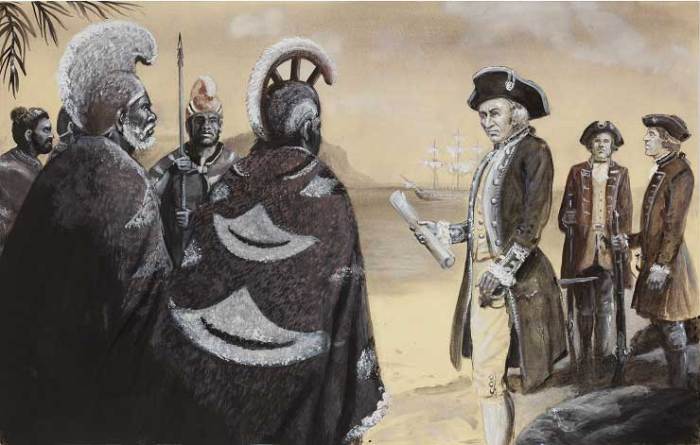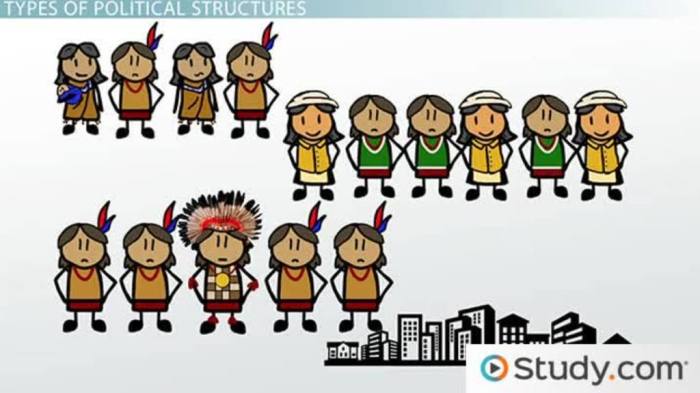Bands tribes chiefdoms and states – Bands, tribes, chiefdoms, and states represent distinct stages in the evolution of human political organization. From the small-scale egalitarianism of bands to the centralized authority of states, each form exhibits unique characteristics that reflect the social, economic, and political dynamics of its time.
This comprehensive overview delves into the defining features, advantages, and disadvantages of each type of organization, tracing their historical development and examining the factors that drive transitions between them. By understanding these different levels of political complexity, we gain a deeper appreciation for the diversity and adaptability of human societies throughout history.
Bands

Bands are small-scale, egalitarian societies characterized by kinship ties and face-to-face interactions. They typically lack formal leadership or social stratification and engage in hunting, gathering, and fishing for subsistence.
Examples of Bands, Bands tribes chiefdoms and states
- Mbuti people of the Congo Basin
- Hadza people of Tanzania
- Inuit people of the Arctic
Advantages and Disadvantages of Band Societies
- Advantages:Strong sense of community, flexible social organization, egalitarian decision-making.
- Disadvantages:Limited access to resources, vulnerability to environmental changes, difficulty in resolving conflicts.
Tribes
Tribes are larger and more complex than bands, with a population typically ranging from several hundred to several thousand. They have a more elaborate social structure, often with a recognized leader or chief, and may engage in agriculture, pastoralism, or both.
Examples of Tribes
- Navajo Nation of the American Southwest
- Maasai people of East Africa
- Celtic tribes of ancient Europe
Role of Kinship and Leadership in Tribal Societies
Kinship plays a crucial role in tribal societies, defining social obligations and access to resources. Leadership is typically based on personal qualities, such as hunting prowess or wisdom, rather than inherited status.
Chiefdoms
Chiefdoms are societies that are more complex than tribes, with a centralized authority and a larger population. They often emerge when tribes expand and incorporate other groups, leading to the development of a hierarchical social structure and a specialized economy.
Political and Economic Structures of Chiefdoms
Chiefdoms are characterized by a chief who has limited political and economic power. The chief typically controls land allocation, warfare, and trade and may have a council of advisors or elders.
Examples of Chiefdoms
- Hawaiian chiefdoms
- Mississippian chiefdoms of North America
- Ashanti Empire of West Africa
States: Bands Tribes Chiefdoms And States

States are the most complex form of political organization, characterized by sovereignty, territoriality, and centralized authority. They typically have a bureaucracy, a standing army, and a system of taxation.
Comparison of States with Other Forms of Organization
- Bands:Egalitarian, kinship-based, lack formal leadership.
- Tribes:Larger, more complex, have a recognized leader, engage in agriculture or pastoralism.
- Chiefdoms:Centralized authority, hierarchical social structure, specialized economy.
- States:Sovereign, territorial, centralized authority, bureaucracy, standing army, taxation.
Relationships and Transitions
The relationships between bands, tribes, chiefdoms, and states are fluid, and transitions from one form of organization to another can occur due to various factors, such as population growth, technological advancements, and environmental changes.
Factors Leading to Transitions
- Population growth:As populations expand, resources become more scarce, leading to competition and conflict, which can trigger the formation of more complex political structures.
- Technological advancements:The development of new technologies, such as agriculture or metallurgy, can increase productivity and create surpluses, allowing for the accumulation of wealth and the emergence of elites.
- Environmental changes:Changes in the environment, such as climate shifts or natural disasters, can disrupt traditional ways of life and force people to adapt, potentially leading to the formation of new political structures.
User Queries
What is the primary difference between a band and a tribe?
Bands are small, egalitarian groups with minimal social hierarchy and political organization, while tribes are larger, more complex societies with a defined leadership structure and social stratification.
How did chiefdoms emerge from tribal societies?
Chiefdoms arose when certain individuals or lineages gained control over resources and decision-making, leading to the development of centralized authority and social inequality.
What factors contributed to the rise of states?
The development of states was driven by factors such as population growth, technological advancements, and the need for centralized authority to manage complex societies and territories.